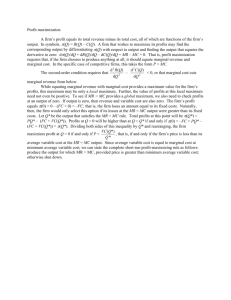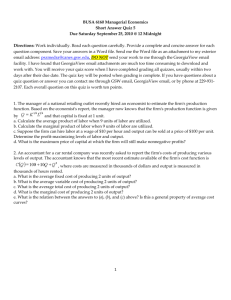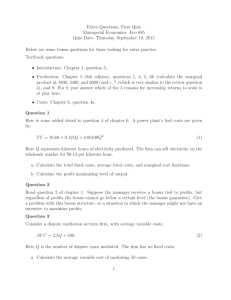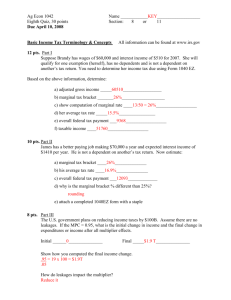First Quiz Managerial Economics: Eco 685, Section 52 Economic
advertisement
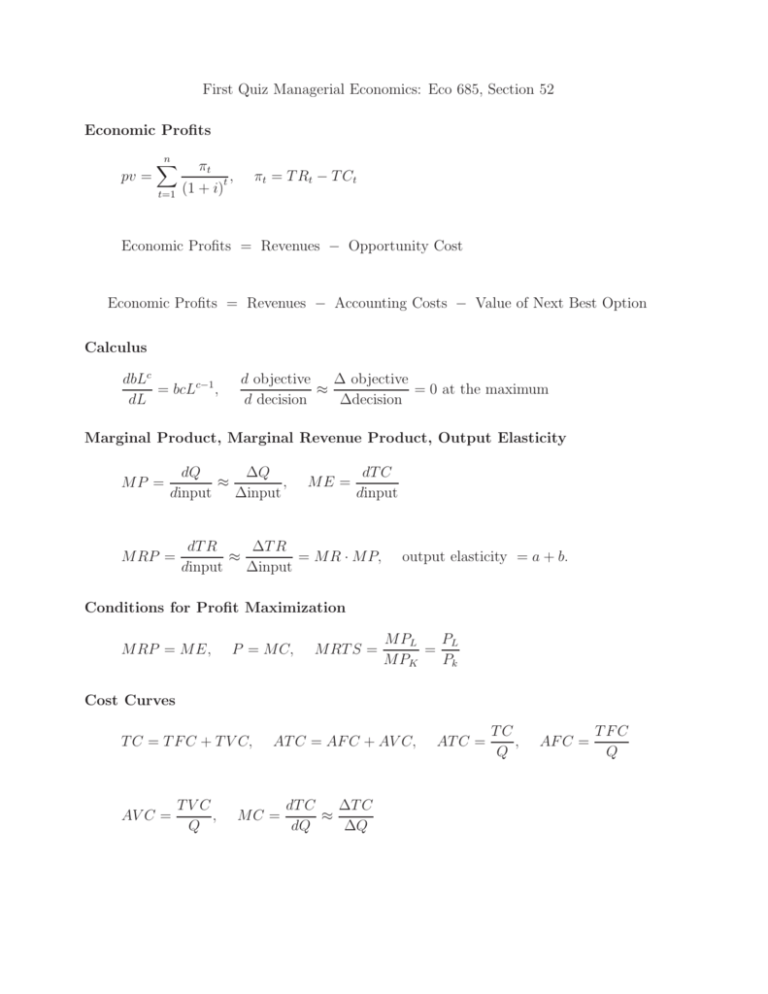
First Quiz Managerial Economics: Eco 685, Section 52 Economic Profits pv = n X t=1 πt , (1 + i)t πt = T Rt − T Ct Economic Profits = Revenues − Opportunity Cost Economic Profits = Revenues − Accounting Costs − Value of Next Best Option Calculus dbLc = bcLc−1 , dL ∆ objective d objective ≈ = 0 at the maximum d decision ∆decision Marginal Product, Marginal Revenue Product, Output Elasticity MP = ∆Q dQ ≈ , dinput ∆input MRP = ME = dT C dinput ∆T R dT R ≈ = MR · MP, dinput ∆input output elasticity = a + b. Conditions for Profit Maximization MRP = ME, P = MC, MRT S = MPL PL = MPK Pk Cost Curves T C = T F C + T V C, AV C = TV C , Q AT C = AF C + AV C, MC = dT C ∆T C ≈ dQ ∆Q AT C = TC , Q AF C = TFC Q The test is closed notes and goes until 11:30. Write all answers, including tables, in the blue book! Question 1 (12 points) Classify each of the following production functions as increasing, constant, or decreasing returns to scale in all inputs. Also, would you expect firms in the industry to merge (yes/no for each)? a. Apparel and Textiles: Q = L0.33 K 0.18 . b. Plate glass manufacturing: Q = 3.28 (K 0.256 ) (L0.953 ). c. UK Supermarkets: Q = 11.7L0.13 K 0.1 M 0.66 , here M is energy and materials. d. Homework production: Q = C · S, where C is cups of coffee, and S is students. Question 2 (10 points) On CNBC on Wednesday morning, the CEO of Auto Nation discussed why GM rejected a merger offer from Fiat/Chrysler: “To dance you need a partner. GM has a strategy. GM does not want to be distracted from executing their strategy by a merger.” Which of the following are true for GM (answer true/false for each): a. GM executives believe the accounting profits of the merger are negative. b. GM executives believe the economic profits of the merger are negative. c. For GM, an opportunity cost of the merger is the time that could be spent on the strategy. d. Opportunity costs do not include accounting costs. Question 3 (18 points) A firm which caters birthday parties for kids has the following cost data: • Total fixed costs are $100. • Total variable costs are 25Q + 21 Q2 , where Q is the number of kids at the party. • The price is $45 per kid. a. Compute the total cost of a party with 30 kids. b. Compute the average total cost of a party with 30 kids. c. Compute the marginal cost of a party with 30 kids. 1 d. Compute the number of kids which maximizes profits. e. Compute total profits for the number of kids you found in part (d). f. The owner argues: “we should have 30 kids at the party so we can spread our fixed costs over more units.” Do you agree? Question 4 (20 points) A software firm uses software engineers (E) and programmers (G). Suppose the marginal product of engineers is 1/2 and the marginal product of programmers is 3. Engineers earn a salary of $100 thousand, whereas programmers earn $200 thousand. a. Give one way to reduce costs while keeping production constant. b. Calculate the savings to the firm when the cost reduction plan in (a) is implemented. c. Give one way to increase production while keeping costs constant. d. Calculate the increase in production if your answer to (c) is implemented. Question 5 (20 points) For each, calculate sunk, fixed, and variable costs (if any) a. On the first of the month, a firm paid $1,000 rent for an office space. After paying the rent, the firm now has an opportunity sublet the office for $800. b. Apple must pay a royalty for use of patented technology on the Iphone. The royalty is $25 per phone and Apple sells 100 phones. c. Dave’s frisbee league pays $500 for field rentals in advance. The league has 40 players, and each player receives a $10 t-shirt. Question 6 (20 points) Suppose the price of labor is $1,000 and the price of capital is $4,000. Suppose further the following data for silicon wafer production: Labor (L) 0 10 20 Capital (machines, K) 0 1 2 0 0 0 200 500 1000 300 900 1200 Table 1: Silicon wafer production. 2 a. Calculate the marginal product of labor: Labor (L) 0 10 20 Capital (machines, K) 0 1 2 NA NA NA NA NA Table 2: Marginal Product of Labor. Calculate the marginal product of capital: Labor (L) 0 10 20 Capital (machines, K) 0 1 2 NA NA NA NA NA Table 3: Marginal Product of capital. Calculate the marginal rate of technical substitution: Labor (L) 0 10 20 Capital (machines, K) 0 1 2 NA NA NA NA NA Table 4: Marginal rate of technical substitution. b. Suppose currently 1 machine (capital) is in use, along with 10 workers. Give a change in inputs which keeps production approximately constant but reduces costs. c. For what combination of inputs is closest to optimal? 3

